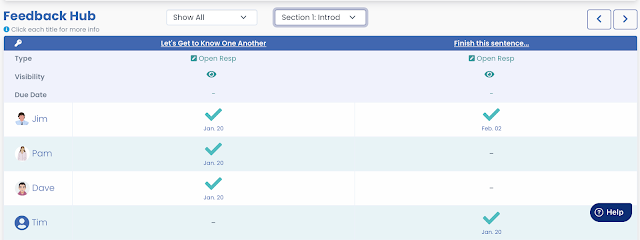Step into IB MYP Teacher Mike Nicholaides' 7th Grade Individuals and Societies classroom and it's a little louder than most. You'll often find students partnered up or in groups exchanging ideas on work. He's a fan of having students construct their own meaning. Usually this means a good deal of peer and self evaluation to monitor progress and foster growth along the way.
In his current unit on Globalization, he's asking students to create a visual representations of how different resources move throughout the world - and prioritize the importance that each of these exchanges had on the impact of the era. Each student has their role and the entire picture contributes to the whole. it's a project that takes a few days to materialize.
To really understand the complex concept of globalization, it's important that students are able to easily see multiple perspectives. And, they need to receive a variety of ideas from these other perspectives.
Like any project, success is both a factor of the content that is learned and the process that students follow.
I try to set up opportunities for each to self assess, give feedback to others, and reflect whether those exercises and the feedback received can fuel future improvements.
One challenge that Nicholaides faces is finding time within the unit for these formative steps to take place.
Usually, these peer and self-assessment practices are done with individual tasks. It's valuable learning, but it means a lot of individually shared documents and group work during class time. Not only can these logistics be time-consuming, with all of the separate tasks and discussions, it can be hard for each student to synthesize it all to take next steps.
During this unit, Nicholaides is supplementing his MS Teams platform by turning to Huddle Up to help the entire class save time and stay more organized.
Typically, he would create a customized rubric to help define the assessment criteria, and that rubric would serve as the foundation for feedback. Now, he's added that rubric directly into Huddle Up, allowing each student to "Huddle" and give feedback to one another within the same system. Students aren't limited to getting feedback from one person, but now those rubric scores can show data trends. Students the synthesized and the individual data - all organized easily to help foster improvement.
Huddle Up just connects everything. These are the same tasks I would have shared as separate docs, but now they’re in Huddle Up and and it’s all organized. So, students don’t have to save and share everything, and the feedback data is right there too. It's like a virtual, organized version of a Gallery Walk.
Nicholaides sees hope that Huddle Up's transparency will help solve an even bigger problem - the difficulty some students have in completing the necessary steps in the process. Because the interactive nature of Huddle Up makes each individual's progress visible to the group.
It not only helps students see the quality of others' work, but also the process. They can see the steps that others are taking, and how they are completing those steps. It lets them see everyone’s progress along the way so the learning is less isolating. Ultimately, that transparency is going to improve the quality of the work that is shared.
A topic like globalization is more like a mosaic. In order to grasp the big picture, students really have to learn from multiple perspectives and understand that different factors affected different regions of the world differently. That's tough to do without really engaging way to share information and insights easily.
Nicholaides certainly isn't abandoning the noisy group work. Much like a flipped classroom, by having students compete initial feedback outside of class time and having all of that data organized and accessible, the group work and face-to-face time can be used for more detailed and nuanced discussions.
Ultimately, I want to give students more opportunities to create and give feedback. Huddle Up helps me do this in a more focused manner.
Mike is a teacher at the Shanghai Community International School (SCIS), an American accredited international school in Shanghai China serving 50+ nationalities. SCIS is an IB World School offering the PYP, MYP, and DP Program.
You can learn more about Huddle Up Learning's interactive platform from the videos below. www.huddleuplearning.com
Project Homepage Navigation (2:12)



Comments
Post a Comment